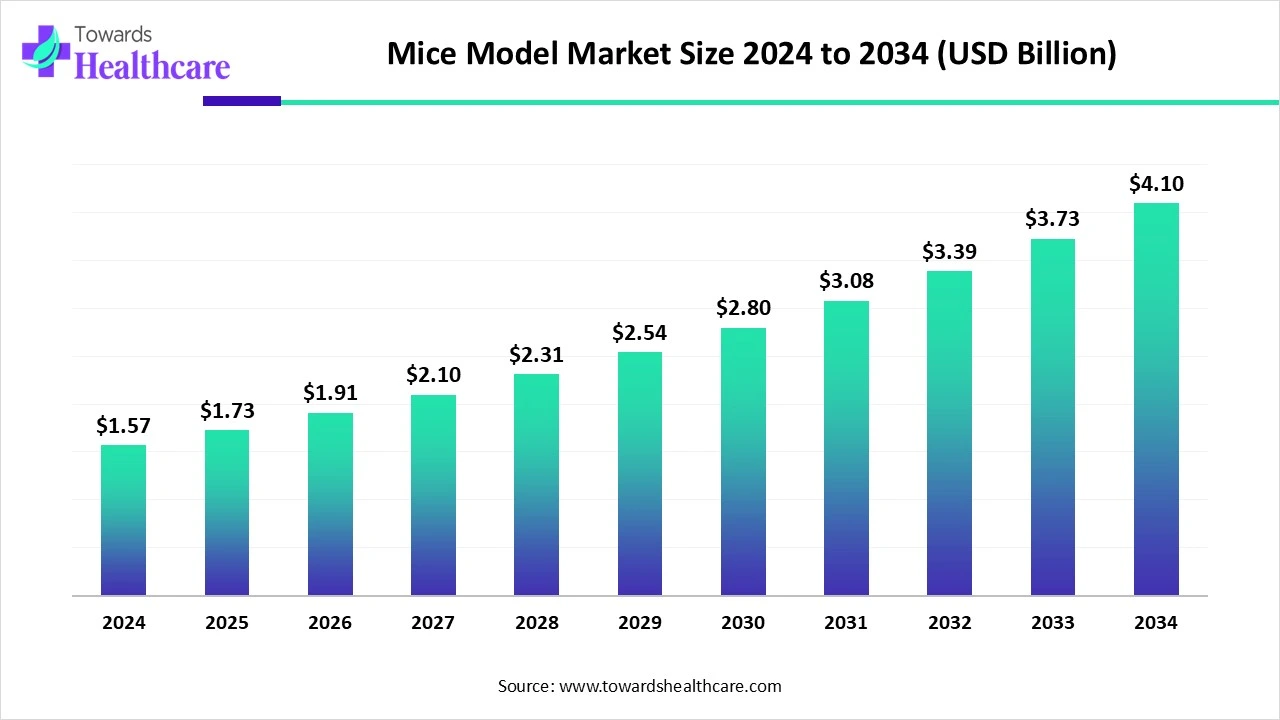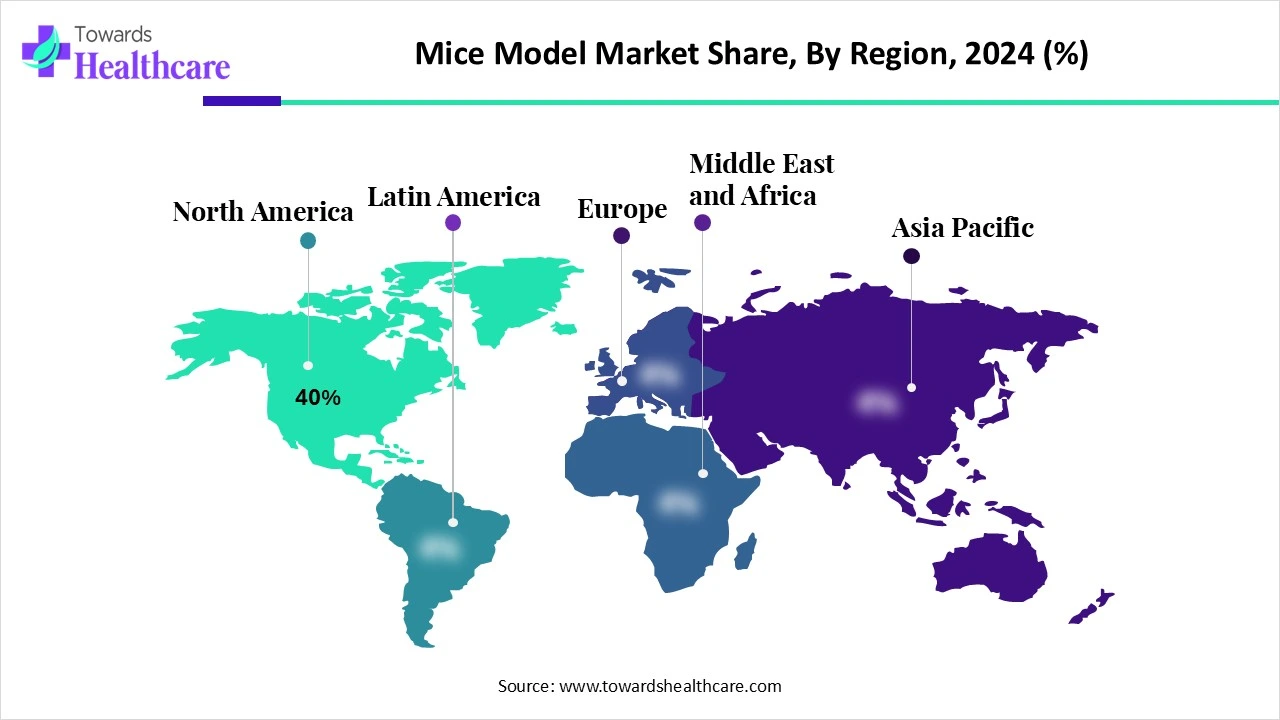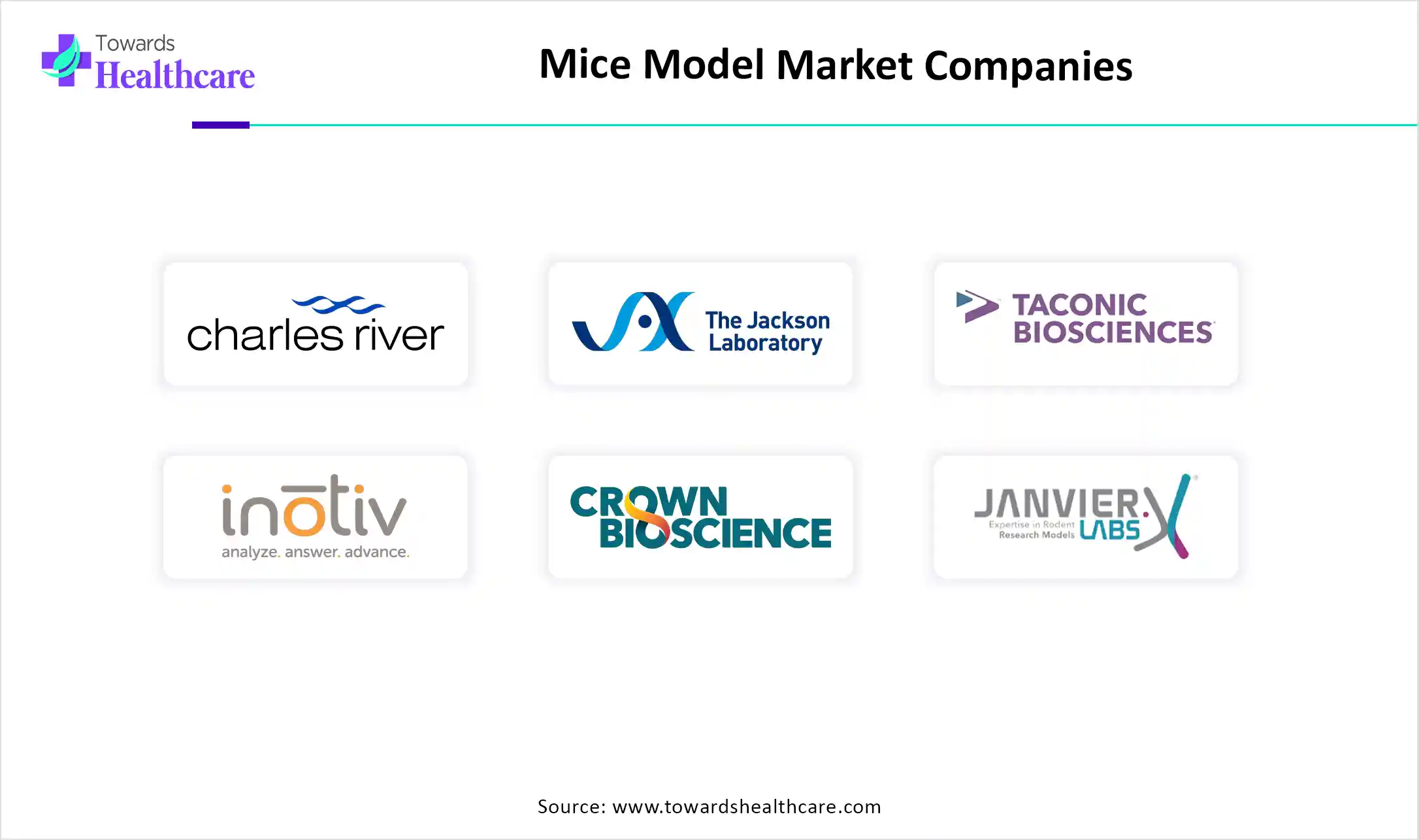November 2025

The global mice model market size is calculated at US$ 1.57 in 2024, grew to US$ 1.73 billion in 2025, and is projected to reach around US$ 4.1 billion by 2034. The market is expanding at a CAGR of 10.04% between 2025 and 2034.

Around 80% of human genetic components are present in mice, which is another important factor in the favour for mouse models over their counterparts. Mouse models are expected to become increasingly in demand as a result of the rise in medical researchers who are trying to understand more about diseases like HIV and cancer that currently have no known solutions. Additionally, the business may benefit from the increasing adoption of innovative techniques for producing a batch of mouse models that are more effective throughout the projection period. The industry's overall income is significantly impacted by ethical concerns and procedure enquiries because of the usage of mouse models, which is linked to parts of animal cruelty.
| Metric | Details |
| Market Size in 2025 | USD 1.73 Billion |
| Projected Market Size in 2034 | USD 4.1 Billion |
| CAGR (2025 - 2034) | 10.04% |
| Leading Region | North America Share 40% |
| Market Segmentation | By Model Type, By Application, By End User, By Product Type, By Region |
| Top Key Players | Charles River Laboratories International, Inc., The Jackson Laboratory, Taconic Biosciences, Inc., Envigo (a subsidiary of Inotiv), Crown Bioscience, Inc., Janvier Labs, Biocytogen Co., Ltd., Shanghai Model Organisms Center, Inc. (SMOC), GemPharmatech Co., Ltd., Cyagen Biosciences Inc., Oriental BioService Inc., Harlan Laboratories (now part of Envigo), Beijing Biocytogen Co., Ltd., Transgenic Inc., SAGE Labs (part of BioIVT), GenOway, Ingenious Targeting Laboratory, Inc. (iTL), Taconic Artemis GmbH, China Jackson Laboratories, Model Animal Research Center of Nanjing University (MARC) |
The mice model market refers to the global market involved in the development, manufacturing, and distribution of laboratory mice used primarily for biomedical research, drug discovery, toxicology testing services, genetic studies, and disease modeling. These models are critical tools in preclinical trials and enable researchers to understand human disease mechanisms and evaluate the efficacy and safety of new therapies. The market includes various types of mouse models, such as genetically engineered models, immunodeficient mice, transgenic mice, and wild-type strains, supported by breeding and supply services.
The use of AI and ML to animal research has shown promising promise in terms of increasing translation and repeatability while strengthening traditional techniques such as animal models. AI and ML may optimise preclinical research using animal models by analysing complex datasets, improving experimental design, and predicting results. This link might help researchers extract more useful information from animal research. Combining AI/ML analyses of animal model data with human clinical data can improve the translation of outcomes.
Rising Usage of Developing Personalized Medicine
Because they enable researchers to examine human diseases in a controlled setting and test possible treatments before they are used on humans, mouse models are essential to precision medicine. These models, especially genetically engineered mice, provide a framework for examining the processes underlying illness, locating potential therapeutic targets, and assessing the efficacy and safety of novel therapies.
Ethical Concerns in Using Animal Models
In order to further human understanding and help address biological and biomedical issues, experimental research has employed animal models. However, rising knowledge of animal rights and concern for the welfare of the animals employed have led to a greater attention on the associated ethical concerns, which has hindered the mice model market.
Gene Editing Technological Advancements
CRISPR/Cas9 and other genetic modification techniques have revolutionised the accuracy of altering mouse genomes. As genetic engineering continues to progress, scientists may modify mouse models to precisely resemble particular human diseases or genetic abnormalities. The ongoing development and significance of mouse models in biomedical research and drug development are fueled by their ability to foster innovation in research and improve disease modelling skills. These developments support improvements in human health and medicine.
By model type, the genetically engineered mice models segment held the largest share of the mice model market in 2024. Many uses in biotechnology, medicine, and research have benefited from the capacity to modify the mouse genome. In order to simulate genetic abnormalities, comprehend embryonic development, and assess treatments, genetically engineered mouse models, or GEMMs, have emerged as important tools. These mice and their cell lines have also sped up fundamental research by enabling scientists to change the cellular or biochemical characteristics of proteins, deconstruct genetic pathways, and assign roles to genes.
By model type, the humanized mice segment is estimated to achieve the highest CAGR during the forecast period. Preclinical techniques such as humanised mice are useful because they allow researchers to conduct more translationally relevant experiments. These models are mice that have human tissues, cells, genes, or microbiome in them. Without a doubt, humanised mice have transformed biomedical science. They offer a vital platform for comprehending human biology, simulating complicated illnesses, and hastening the creation of safer and more efficient treatments by bridging the crucial gap between conventional animal models and human patients.
By application, the cancer research segment led the mice model market in 2024. The biology of cancer has been greatly advanced by genetically modified mice models. Verifying gene functions, finding new cancer genes and tumour biomarkers, understanding the molecular and cellular mechanisms behind tumour initiation and multistage tumorigenesis, and improving clinical models to test new treatment approaches are all areas in which they have shown promise.
By application, the neuroscience segment is expected to witness the highest CAGR by 2025-2034. The ageing of the world's population and the rising incidence of neurological illnesses place significant strain on healthcare systems and socioeconomic stability globally. For many years, animal models have been an essential part of neuroscience research, offering valuable insights into the biological and evolutionary principles of behaviour, illness, and the nervous system.
By end-user, the pharmaceutical & biotechnology companies segment was dominant in the mice model market in 2024. The segment is growing due to growing research and clinical trials in developing advanced therapeutics and personalized treatments. Pharmaceutical medication research and development now heavily relies on biotechnological techniques. Biopharmaceuticals generate a significant portion of medicine sales. Oncology, metabolic diseases, and musculoskeletal ailments are the most pertinent indications. It is anticipated that the importance of biopharmaceuticals will only grow in the future. The majority of compounds in preclinical testing at the moment depend on biotechnology.
By end-user, the academic & research institutes segment is anticipated to be the fastest-growing during the forecast period. The animals utilised in different research projects have anything to do with the progression of human history. Mice's tiny size, ease of handling, and genetic alteration possibilities have made them a popular choice for biological and biomedical research. As a result, mice are often used in clinical studies by academic and scientific organisations.
By product type, the live mice segment held the major share of the mice model market in 2024. Since live mice are inexpensive and effective models because of their tiny size, short lifespans, high rates of reproduction, and genetic resemblance to humans, they are widely employed in research, especially in biomedical and genetic investigations. Their well-characterized immunological, endocrine, and neurological systems offer a pertinent platform for researching illness causes, testing possible treatments, and comprehending fundamental biological processes. Their genetic composition is also around 99% comparable to that of humans.
By product type, the custom mice model services segment is expected to grow at the highest rate during the upcoming period. In the age of precision medicine, mouse model-based approaches must be re-examined in order to accurately simulate human populations. One prospective paradigm that might facilitate the adoption of innovative precision medicine techniques is systems genetics.

North America dominated the mice model market share by 40% in 2024. The need for mice models will increase in the area due to the rise in the occurrence of various serious illnesses, such as cancer, diabetes, viral infections, and cardiovascular diseases (CVDs). Furthermore, the existence of a healthcare sector that relies significantly on research has a significant impact on North American income. Countries like the United States and Canada invest a lot of money in medical research, which increases the need for and usage of genetically modified mice models.
Today, an estimated 7.2 million Americans 65 and older suffer with Alzheimer's disease. By 2060, this figure may rise to 13.8 million if no new treatments are developed to prevent or treat AD. People with Alzheimer's or other dementias received an estimated 19.2 billion hours of care in 2024 from about 12 million family members and other unpaid carers. The expected total 2025 spending for health care, long-term care, and hospice services for individuals with dementia aged 65 and above is $384 billion.
Canada's health research system is renowned around the world for its superior quality. In order to realise our common goal of enhancing Canadians' physical and mental well-being, CIHR-supported research is essential. More than $1.3 billion in financing was announced by the Health Minister in July 2025 to assist more than 9,700 researchers and research initiatives throughout Canada.
Asia Pacific is estimated to host the fastest-growing mice model market during the forecast period. The first factor driving the need for mouse models is rising biomedical research and development expenditures in nations like China, Japan, and India. Second, mouse models for preclinical research are being used more often as a result of increased biotechnology and pharmaceutical activity as well as a growing emphasis on personalised therapy. Finally, growing academic-industry partnerships support market expansion in the Asia-Pacific area.
When it comes to managing medical services and public health issues for the Chinese people, China's healthcare system has achieved significant progress. China offers intriguing and distinctive study possibilities for a variety of reasons. There are many patients with several relatively uncommon diseases in China, which makes it a good place to do clinical research.
India's pharmaceutical industry is more than just a business; it's essential. With initiatives like Bulk Drug Parks, PMBJP, and PLI, the Modi administration is making sure that no one is left behind in terms of healthcare. Research and lab renovations are funded under the ₹500 crore Strengthening of Pharmaceuticals Industry (SPI) Scheme, which helps Indian businesses compete internationally. Due to these efforts, medications are produced in India for both India and the rest of the globe, maintaining high quality and affordable pricing.
Europe is expected to grow significantly in the mice model market during the forecast period. There is a significant need for mouse models due to Europe's robust biomedical research infrastructure, which is supported by prestigious universities and research organisations. The European government's financing and research and development initiatives also contribute to the market's expansion, making Europe a major player in the global mouse model industry.
Germany is the biggest pharmaceutical market in Europe and the fourth largest in the world. The pharmaceutical strategy highlights the industry's significant significance to the federal government. In conjunction with the previously proposed legislation, Germany will further establish itself as a leader in both manufacturing and research and development in Europe.

| Companies | Headquarters | Offerings |
| Taconic Biosciences | New York, United States | Offers genetically engineered, immune-oncology, diet-induced, and additional specialized mouse models. |
| Charles River Laboratories, Inc. | Wilmington, Massachusetts, United States | Provides high-quality research animal models, such as inbred mice, outbred mice, immunodeficient mice, and hybrid mice. |
| The Jackson Laboratory | Maine, United States | Provides access to over 14,000 strains from an extensive repository or collaborates with researchers to develop a custom model. |
| Biocytogen | Beijing, China | Humanized mouse models for immune-oncology and autoimmune/inflammatory disease targets. |
In January 2024, in addition to helping us better understand sperm function, this mouse model will also help us better understand human infertility processes, said Roy Cohen, a research assistant professor at the Baker Institute who oversaw the mouse model's creation. The complex problem of human infertility may be approached after some of the fundamental concerns in a model system have been addressed and you have a clearer understanding of how things operate.
By Model Type
By Application
By End User
By Product Type
By Region
November 2025
November 2025
November 2025
November 2025